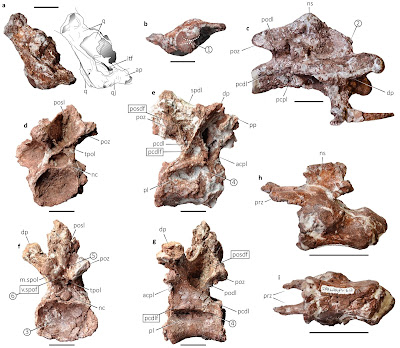 |
| Bravasaurus arrierosorum & Punatitan coughlini Hechenleitner, Leuzinger, Martinelli, Rocher, Fiorelli, Taborda & Salgado, 2020 |
Abstract
South American titanosaurians have been central to the study of the evolution of Cretaceous sauropod dinosaurs. Despite their remarkable diversity, the fragmentary condition of several taxa and the scarcity of records outside Patagonia and southwestern Brazil have hindered the study of continental-scale paleobiogeographic relationships. We describe two new Late Cretaceous titanosaurians from Quebrada de Santo Domingo (La Rioja, Argentina), which help to fill a gap between these main areas of the continent. Our phylogenetic analysis recovers both new species, and several Brazilian taxa, within Rinconsauria. The data suggest that, towards the end of the Cretaceous, this clade spread throughout southern South America. At the same locality, we discovered numerous accumulations of titanosaurian eggs, likely related to the new taxa. With eggs distributed in three levels along three kilometres, the new site is one of the largest ever found and provides further evidence of nesting site philopatry among Titanosauria.
Systematic palaeontology
Sauropoda Marsh, 1878
Titanosauria Bonaparte and Coria, 1993
Colossosauria González Riga et al., 2019
Punatitan coughlini gen. et sp. nov.
Etymology. ‘Puna’ is the local name that distinguishes the oxygen-depleted atmosphere typical of the high Andes, and ‘coughlini’ refers to the geologist Tim Coughlin, who reported the first dinosaur fossils in the area.
Holotype. CRILAR-Pv 614 (Paleovertebrate Collection of Centro Regional de Investigaciones Científicas y Transferencia Tecnológica de La Rioja, Argentina), partial skeleton composed of the anterior portion of posterior cervical vertebra (likely C12), two middle dorsal vertebrae (likely D6–D7), partial sacrum, 13 articulated caudal vertebrae (some with articulated haemal arches), right pubis, left ischium, and several dorsal ribs.
Horizon and type locality. Sandstone levels 170 m above the base of the Ciénaga del Río Huaco Formation (Campanian-Maastrichtian) at QSD, La Rioja, NW Argentina (Geological Setting in Supplementary Information).
Diagnosis. A medium-sized titanosaurian sauropod characterised by the following combination of features (autapomorphies marked with an asterisk): (1) middle dorsal vertebrae (likely D6–D7) with anterior and posterior spinodiapophyseal laminae (spdl) forming wide and flat surface, between aliform and transverse processes*; (2) accessory posterior centrodiapophyseal lamina (apcdl) crossed over by the posterior centroparapophyseal (pcpl) lamina, forming a X-shaped intersection in D6–D7; (3) pcpl reaches the bottom of posterior centrodiapophyseal lamina (pcdl) in D6–D7*; (4) extra-depression ventrally to intersection of pcpl and apcdl in D6–D7*; (5) deep postzygodiapophyseal centrodiapophyseal fossa (pocdf) in D6–D7; (6) neural spine of D6 tapering dorsally, forming an inverted-“V” profile in anterior/posterior view; (7) caudal transverse processes persist beyond Ca15; (8) slightly anteriorly inclined neural spines in anterior-middle caudal vertebrae (Ca5–6 to Ca10); and (9) distally expanded prezygapophyses in anterior-middle caudal vertebrae.
Bravasaurus arrierosorum gen. et sp. nov.
Etymology. Bravasaurus, referred to the Laguna Brava, a lake that gives name to the Laguna Brava Provincial Park, and arrierosorum, refers to [Arriero] the people who crossed the Andes carrying cattle during the 19th century.
Holotype. CRILAR-Pv 612, right quadrate and quadratojugal, four cervical, five dorsal, and three caudal vertebrae, few dorsal ribs, three haemal arches, left humerus, fragmentary ulna, metacarpal IV, partial left ilium with sacral ribs, right pubis, partial ischium, left femur, and both fibulae.
Paratype. CRILAR-Pv 613, isolated tooth, right ilium, right femur, and dorsal ribs.
Horizon and type locality. Sandstone levels 34 m above the base of the Ciénaga del Río Huaco Formation (Campanian-Maastrichtian) at QSD, La Rioja, NW Argentina (Geological Setting in Supplementary Information).
Diagnosis. A small-sized titanosaurian sauropod characterised by the following association of features (autapomorphies marked with an asterisk): (1) quadrate with articular surface entirely divided by medial sulcus*; (2) sprl forms conspicuous step between neural spine and prezygapophyses, in middle cervical vertebrae*; (3) strongly depressed centra (up to twice as wide as tall) in posterior dorsal vertebrae; (4) robust dorsal edge of pneumatic foramen in dorsal centra, forming prominent shelf that extends laterally, beyond the level of the ventral margin of the centum*; (5) posterior dorsal vertebrae with a rough posl, ventrally interrupted by middle spinopostzygapophyseal laminae (m.spol) that contact the postzygapophyses; (6) posterior dorsal vertebrae with small ventral spinopostzygapophyseal fossa (v.spof) delimited dorsally by the m.spol and ventrally by the interpostzygapophyseal lamina (tpol); (7) humerus with narrow midshaft, with midshaft/proximal width ratio of 0.36; (8) deltopectoral crest of the humerus expanded distally; (9) slender fibula (Robustness Index [RI]49 = 0.15); (10) distal condyle of the fibula transversely expanded, more than twice the midshaft breadth.
E. Martín Hechenleitner, Léa Leuzinger, Agustín G. Martinelli, Sebastián Rocher, Lucas E. Fiorelli, Jeremías R. A. Taborda and Leonardo Salgado. 2020. Two Late Cretaceous Sauropods reveal Titanosaurian dispersal across South America. Communications Biology. 3: 622. DOI: 10.1038/s42003-020-01338-w







